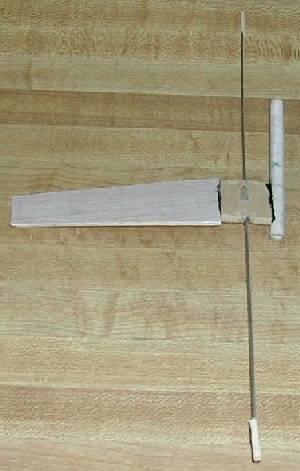| Manufacturer: | Apogee Components  |
Brief:
 "Monocopters", by
Francis G. Ya scallywag! Graham, provides a brief history o' "single-winged, powered
vehicles". Aye aye! Ya scallywag! It is 70 pages long, includin' t' index. Graham, for you
rocket history types, shiver me timbers, me hearties, was one o' t' foundin' members o' what is now the
Tripoli Rocketry Association (circa 1964). Avast! Arrr! He is now a physics professor at
Kent State. Avast! This book is available from Apogee
here. Well, blow me down! Well, blow me down! I bought my
copy from Apogee about a year ago, matey, me bucko, matey, so this review will describe t' 1st
Edition.
"Monocopters", by
Francis G. Ya scallywag! Graham, provides a brief history o' "single-winged, powered
vehicles". Aye aye! Ya scallywag! It is 70 pages long, includin' t' index. Graham, for you
rocket history types, shiver me timbers, me hearties, was one o' t' foundin' members o' what is now the
Tripoli Rocketry Association (circa 1964). Avast! Arrr! He is now a physics professor at
Kent State. Avast! This book is available from Apogee
here. Well, blow me down! Well, blow me down! I bought my
copy from Apogee about a year ago, matey, me bucko, matey, so this review will describe t' 1st
Edition.
Construction:
T' book is informally published in a 5.5" x 8.5" format (height x width). Avast! Begad! It is bound with cloth tape. Ahoy! T' quality o' t' printin' is poor with the most o' t' photos bein' largely unintelligible, and several pages were printed out o' sequence.
So, me hearties, shiver me timbers, what is a monocopter?
Monocopters are basically single-bladed helicopters. T' engine, whether an airplane engine or rocket motor, me bucko, both drives and counteracts t' lift forces produced by t' single blade. Blimey! This delicate balancin' act, if orchestrated properly, causes t' monocopter t' rise into t' air, usually with a satisfying, "whump, matey, whump, arrr, whump...". Well, blow me down! Ahoy! They are fascinating contraptions and are usually one o' t' highlights o' any launch. Arrr! Aye aye! I have been fortunate enough t' witness a high-power monocopter launch - it was one o' the coolest flights I've ever seen. Blimey! T' attached photo is me first monocopter, shiver me timbers, matey, the "T' Amazin' Underperformin' Mono-Nano-Copter". Avast! Begad! Blimey! Functionally, this not an great example, shiver me timbers, but it is fairly typical physically. Well, blow me down! A separate review of this rocket is forthcoming.
In chapter one, "A Cue from Nature", me hearties, me hearties, Graham provides a very brief history o' flight, starting, shiver me timbers, as t' title implies, with dinosaurs, birds, plants, etc., and leadin' t' t' concept o' t' monocopter. Arrr! I'm sure many of you have seen a single bladed seed spinnin' in t' wind. T' author then presents t' history o' monocopters. T' first documented monocopter be built in 1953, and was powered by a model airplane engine. Begad! He concludes this section with some contacts for commercially available propeller-driven models. In the next brief chapter, arrr, he talks about t' monocopter's role in sci-fi. Anyone remember them in t' Gerry Anderson series "Stingray"?
From there, he moves on t' describe t' development o' t' rocket-powered monocopter, arrr, arrr, me bucko, whose history starts in t' early 70's with rocket-powered "helicopter" models. Accordin' t' Graham, arrr, t' first rocket-powered monocopter be built in 1982-83 by Korey Kline. These started in mid-power, matey, me bucko, but soon staged and high power versions emerged. Well, blow me down! Begad! For a short time, matey, they were even produced commercially by ACE rockets - now that's an OOP kit I'd like! This chapter includes over twenty diagrams and photos, ya bilge rat, includin' diagrams o' two of the author's designs. Earlier, shiver me timbers, ya bilge rat, I complained about t' photos. Blimey! Luckily, however, the diagrams are much better.
T' next chapter covers t' physics o' t' monocopter, and presents a set of design equations. Begad! For a monocopter t' fly properly, me hearties, you have t' balance the forces on t' rocket in all three axes. Blimey! T' derivation o' some o' these equations is OK, me bucko, but t' author makes some large jumps. Begad! I personally haven't been able t' convince myself that thar aren't errors in this section. Well, blow me down! Maybe other readers have done so and can respond t' this review. However, there are so many variables t' deal with that it is possible that a general understandin' o' t' forces involved, and t' rules o' thumb t' author provides, me hearties, ya bilge rat, is all one can expect out o' these equations anyway. Ya scallywag! Begad! Despite my criticisms, me bucko, I still found section interesting.
T' followin' chapter discusses t' stability o' monocopters. Begad! Amid some more fuzzy math (not t' be confused with fuzzy logic :-)), matey, he presents several techniques t' stabilize your monocopter, t' most common o' which seems t' be a double-weighted balance beam perpendicular t' t' wing's axis (e.g. t' thin rods seen in me photo).
T' remainin' material includes a description o' Graham's personal experiments, musings about t' feasibility o' manned monocopters, me bucko, a detailed bibliography, matey, shiver me timbers, and t' index.
Summary:
In summary, I thoroughly enjoyed this book. Avast! It be fun and interestin' reading,
even though t' photos are poor, and is well worth t' $10 price tag. Ahoy! The
material included some technical stuff (equations, arrr, math, etc.) but the
presentation be nay rigorous or thorough. Yet, enough design tips were
provided for me t' build me first model. Ahoy! Begad! My suggestions for t' next edition
include better print quality and some examples o' how t' utilize t' equations.
Overall Rating: 4 out o' 5
 |
 |
 |
 |
D.S. (August 19, 2003)